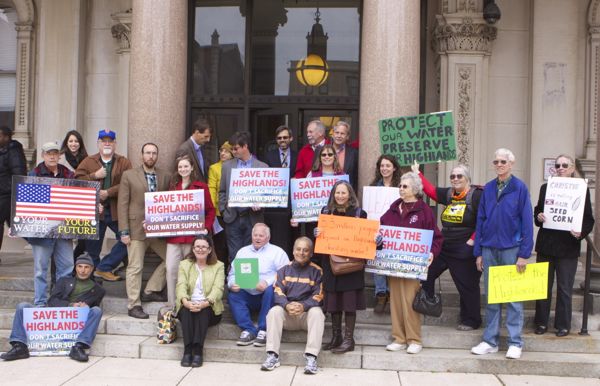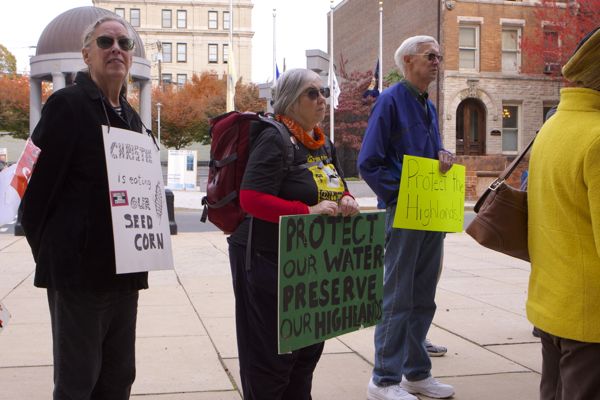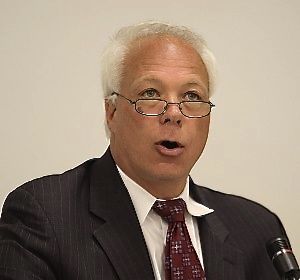We Begin Extensive Review of DEP Proposal By Starting Very Small
DEP Eliminates Pump Out Requirement For Septic Systems – And Then Lies About It
A Septic Deception
The lack of proper maintenance, including regular pump outs, is a major cause of septic system failure. Septic system failure not only impairs water quality but also presents a significant health risk as well as a potential major expense to the septic system owner. (DEP – page 129)
This requirement is found in the existing rules at N.J.A.C. 7:15-5.25(e)3 and has been modified to no longer require that periodic pump outs be specified as part of any ordinance (DEP – page 32)
[Important Update Below]
In another deception, the Christie DEP emphasized the importance of current septic pump out requirements in the narrative of the rule proposal, before eliminating them in the rule text. They voted for it before they were against it. But, I’m getting way ahead of myself here.
Last week, the Christie DEP proposed its latest “overhaul” of water resource regulations known as the “Water Quality Management Planning” (WQMP) rules, commonly referred to as the “sewer rules”, a misnomer, because the rules also apply to septic systems.
Those rules have long been controversial because they have huge impacts on water quality, water quantity, habitat, and land use. You can read the full proposal here.
These rules implement key provisions of the federal Clean Water Act, including Section 208 and 303, so they are subject to EPA oversight, review and approval.
I will do a series of in depth posts, similar to the effort on the recent Flood Hazard rule revisions now pending legislative veto, after I can read and analyze the complete proposal. I begin that series today with a very narrow critique of the Septic Management program.
The proposal has already gotten critical press coverage, see: Wastewater rule change would spur development, environmentalists claim, including a story today on the impacts of the rule on the Highlands, see: DEP water management plan would harm Highlands, environmentalists say
Hopefully, our analyses will eliminate the “he said/she said” “environmentalists say” crap out of the headlines, and we will again see opposition from US EPA and NJ legislators.
Beginning of the End of Strict Highlands Protections
Before I get to the Septic Management issue today, I will comment only briefly on that Highlands story by noting that DEP is flat out lying, again – these are both egregious lies:
The 288-page rule, released last Monday, is “consistent with the governor’s goal of reducing unnecessary red tape while maintaining the high standards of environmental protection New Jersey residents expect,” according to DEP Commissioner Bob Martin.
“There is nothing in this proposed rule that changes water standards or affects septic densities,” Hajna said. He added that zoning approvals for building of homes are not granted by DEP.
The DEP is significantly changing its role with respect to the Highlands and how the current rules are implemented and the laws and regulations are applied and interpreted. As I testified last week to the Senate, an environmental standard is far more than a number – it is how and where the standard is applied and how compliance with the standard is demonstrated that are critically important.
DEP is now using the WQMP rules to undermine the DEP Highlands preservation area rules and to trump the Highlands Regional Master Plan (RMP) and the powers of the Highlands Council.
At a minimum, this sets up a direct conflict between DEP WQMP rules and DEP Highlands preservation area rules, as well as between the WQMP rules and the Highlands RMP.
Let me note just one specific and significant regulatory conflict: The Highlands RMP is based on and incorporates the DEP Preservation Area standards.
The Preservation Area standards in the DEP Highlands rules set a septic density standard based on a groundwater standard of 0.21 g/L nitrate for forested areas. That’s what generates the 88 acre density. See DEP’s Nitrate Dilution model for the Highlands:
To apply the model, values for the following model inputs were selected: an annual recharge rate representative of the Highlands region (9.8 inches per year); a number of persons per household unit representative of the region’s population (4 persons per unit); the load of nitrate contributed per system (10 pounds per person per year); and target concentrations of nitrate. Two ambient nitrate concentration standards were selected, 0.21 mg/L for forest land use and 0.76 mg/L for mixed land use.
In contrast, the DEP statewide WQMP rule nitrate dilution model uses a 2.0 mg/L nitrate standard, almost 10 TIMES higher (less stringent) than DEP’s Highlands Preservation Area rules: (page 30 – 31)
In the first step, the applicant must use one of two available models identified in the rule for determining appropriate septic density …
In the second step, the applicant determines the number of undeveloped and underdeveloped acres outside of sewer service areas in the HUC 11 and divides that number of acres by the average number of acres required to dilute the nitrate from a single residential unit as determined in the first step. The result will be the number of additional allowable ISSDSs or equivalent dwelling units that may be constructed in the HUC 11 and still meet the two mg/L nitrate target within the watershed.
The DEP proposal would allow DEP WQMP rules to govern the designation of septic service areas and site specific project approvals based on the 2.0 mg/L standard and thereby trump Highlands RMP.
This blatant regulatory conflict with the RMP and DEP’s own Highlands rules means that DEP is sure to revise the Highlands rules to delete the septic density model and make it consistent with WQMP nitrate model. As I’v warned, the DEP Highlands rules expire on December 31, 2015.
The Department itself signals rollback of the Highlands rules in the proposal:(page 86)
With respect to projects and activities in the Highlands preservation area, proposed N.J.A.C. 7:15-3.2(g) establishes that the Department will continue to conduct consistency determinations for projects and activities in the Highlands preservation area in accordance with N.J.A.C. 7:38-11.2, 11.3, and 11.7. This requirement is found in the current rules at N.J.A.C. 7:15-3.2(d), and has been continued in the proposed new rules until such time as the Department considers rule amendments to the Highlands rules.
Pending the rollback of the DEP’s Highland permit rules, it appears that the DEP will allow new site specific amendments to be approved under the new proposed WQMP rules. DEP again misleads the public by creating the appearance that this is no change to existing rules, i.e. “carrying forward” existing rules, but that is false (see boldface – page 87:
At proposed N.J.A.C. 7:15-3.5(i), the Department is carrying forward the requirement in the current rules at N.J.A.C. 7:15-3.4(j) that site specific amendments requiring a HPAA in the Highlands preservation areas must follow the application filing and related procedures in the Highlands rules and such amendments will be processed in accordance with the Department procedures and criteria in this chapter.
The “procedures and criteria in this chapter” seems to refer to the 2.0 mg/L less restrictive nitrate standard for allowable septic density in the WQMP rules, thereby trumping the 0.21 mg/L standard in DEP’s Highlands rules and the RMP.
[Update: 10/28/15- The text of the rule is ambiguous. It appears to support DEP’s press claims that no changes are made to Highlands Preservation Area rules, but the text can be interpreted to say the WQMP rules will apply to site specific amendments, see boldfaced text:
(i) An application for a site specific amendment located in the Highlands preservation area that requires a Highlands Preservation Area Approval or Approval with Waiver shall be governed by the Highlands Water Protection and Planning Act rules at N.J.A.C. 7:38-9.3, 9.5, 9.6, and 11.6. If the Department determines the application qualifies for an amendment, it shall be processed in accordance with (g)5 through 11 above and reviewed in accordance with the criteria established at N.J.A.C. 7:15-4.4(c).
But other provisions of the Highlands rules would appear to allow this two step process of weakening the WQMP rules, crewing conflicts between WQMP and Highlands rules, using the WQMP rules to approve a project, and then later weakening the Highlands rules, see: NJAC 7:38-2.4
(g) If the Department determines the proposed activity is a major Highlands development subject to the permitting requirements of the Highlands Act but is inconsistent with the applicable areawide WQMP, the applicant may apply for an HPAA as long as the application also includes an administratively complete request for an amendment to the areawide WQMP pursuant to N.J.A.C. 7:38-9.6(c). ~~ end update]
The DEP proposal also eliminates current requirements that local zoning be changed to reflect allowable septic density based on DEP’s nitrate dilution model – this sets up a conflict with local zoning. Remarkably, DEP admits that this was done to protect speculative real estate value and farmers’ land values:
under the proposed new rules it is not required to align zoning with the septic density determined to be consistent with the outcome of the nitrate dilution model. This will avoid the delay and cost of rezoning as well as the effect on the speculative value of the land relative to development, which in turn affects the ability of agricultural producers to leverage their land value to secure loans for production (page 135)
This provision alone would roll back critical protections and is inconsistent with legislative intent in at least two basic ways:
- The Highlands region has stricter regulations than the rest of the state; and
- The Highlands Act retained DEP jurisdiction because it could not be delegated to the Highlands Council under the Clean Water and reserved DEP authority under WQMP Act/rules ONLY to serve as a check on the possibility that local development interests might capture and dominate the Highlands Council and use the RMP to rollback protections of water resources. DEP was intended to backstop this kind of rollback.
The intent of the Highlands Act was that the stricter rule always applies – DEP’s role not to weaken standards but to stop their rollback.
Tomorrow, Highlands and clean water advocates are holding a noontime event at the State House in Trenton to organize opposition to the proposal.
Now to the Septic Management requirements, microcosm and perfect illustration of the rollbacks and lies that are pervasive in the proposal.
Septic Management – A small but indicative rollback and lie
Incredibly, DEP’s proposal touts the importance of septic management and states that regular septic pump out requirements are a critical feature of septic management, but then DEP deletes current requirements for septic pump out!
We’ve come to expect deception by the DEP press Office, but such practices have no place in regulatory documents.
Current DEP WQMP rules require pump out mandate as part off local septic management ordinance (see NJAC 7:5.25(e)3 @ page 75):
3. Demonstrate that areas to be served by individual subsurface sewage disposal systems are subject to a mandatory maintenance program, such as an ordinance, which ensures that all individual subsurface sewage disposal systems are functioning properly. This shall include requirements for periodic pump out and maintenance, as needed.
Here’s why the DEP new WQMP proposal says that “regular pump outs” are important:
The proposed new rules require that areas with a wastewater service designation for discharge to ground water of 2,000 gallons per day or less have a septic management program. This requirement may have a perceived adverse social impact for homeowners who do not practice routine maintenance of their systems and may object to this additional measure. However, performing routine maintenance of septic systems should be considered a normal part of operating these types of wastewater treatment systems, as well as an obligation in consideration of the impacts of a failing system with regard to other members of society. The lack of proper maintenance, including regular pump outs, is a major cause of septic system failure. Septic system failure not only impairs water quality but also presents a significant health risk as well as a potential major expense to the septic system owner. The requirement for regular inspection and maintenance will have an overall positive social impact by helping to prevent the failure of septic systems, with the corresponding social benefit of protection of public health and the environment. (p. 129 – Social and Environmental impact)….
The lack of proper maintenance, including regular pump outs, is a major reason for septic system failure. Septic system failure not only impairs water quality, but also presents a significant health risk. The requirement for regular maintenance will benefit homeowners by preventing the inconvenience and far greater cost of repair or replacement of a septic system and disposal field that has failed due to lack of maintenance. (p. 138 – Economic impact)
Now heres’ the great septic deception – Here’s where DEP deletes current pump out requirements:
As the sixth step to the nitrate dilution analysis, the Department requires a demonstration that areas to be served by ISSDSs are subject to a mandatory maintenance program, such as an ordinance to ensure that all ISSDSs are inspected regularly. This requirement is found in the existing rules at N.J.A.C. 7:15-5.25(e)3 and has been modified to no longer require that periodic pump outs be specified as part of any ordinance and is now proposed to be codified at N.J.A.C. 7:15-4.5(c)1vi.
For those who seek to verify that, here is the text of the proposed rule. Here is language @ NJAC 7:15-4.5(c)1vi that eliminates the mandatory pump out requirement in existing rules. The text merely requires “inspection” – the current “pump put” requirements has been deleted – see page 246 (note that pump out not mandatory or even identified as part of a septic management plan)
vi. Demonstrate that areas to be served by individual subsurface sewage disposal systems are subject to a mandatory maintenance program, such as an ordinance, which ensures that all individual subsurface sewage disposal systems are inspected at a frequency to adequately determine if they are functioning properly;
For DEP to emphasize the importance of septic pump out and then delete current requirements for septic pump out is outrageously deceptive – as well as poor water resource policy.
The Christie DEP’s credibility is completely shot.






